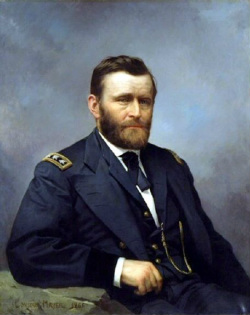Ulysses S. Grant and the Battle of Vicksburg
The Civil War

For the next several years following his resignation from the Army, Grant tried numerous methods to support his family, but all of these plans failed. He moved to Won-Ton-Wish in 1855, near St. Louis, where he had his first daughter, Ellen Wrenshall Grant. In 1856, he built a house called Hardscrabble, where he had another son, Jesse Root Grant. Finally, when the civil war began, Grant signed up as a volunteer on April 23, 1861. He was appointed Colonel in the 21st Illinois Regiment of Volunteers. He was given command of the District of Southern Illinois and Southeastern Missouri, September 4, 1861. Grant fought in several victories and a few major battles. Because of this, Grant was promoted to Major General of Volunteers. Grant fought at the Battle of Shiloh and defeated General Albert Sidney Johnston, considered to be one of the best Confederate soldiers of his time. After several more victories, Grant was appointed Commander of the Department of the Tennessee on October 25, 1862. With this position, Grant led the Siege of Vicksburg. Grant was named commander of the Grand Division of the Mississippi, which placed him in command of the Western theater of the war, on October 16th, 1863. After victory at Chattanooga, Grant was appointed Lieutenant General (the first man to hold this rank since George Washington) and named Supreme Commander of the Union Armies by President Lincoln on March 12th, 1864. Half a year later, Grant met General Robert E. Lee at Petersburg, once again deploying a siege tactic, and defeated him. Grant gave Lee generous surrender terms, which Lee accepted gratefully. Days later, the war ended. Grant is considered one of the best generals in American history. However, in 1868, Grant ran for president and became the 18th President of the United States.
Picture: Ulysses S. Grant painting
Picture: Ulysses S. Grant painting
Site by Alex Sui Gu launched May 18, 2011
Domain: Weebly.com
(c) 2011 All Rights Reserved
Domain: Weebly.com
(c) 2011 All Rights Reserved
